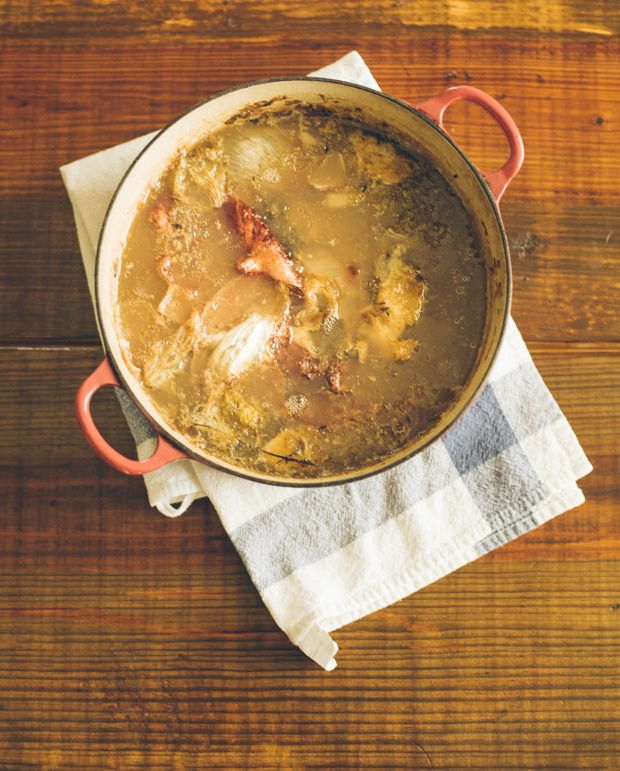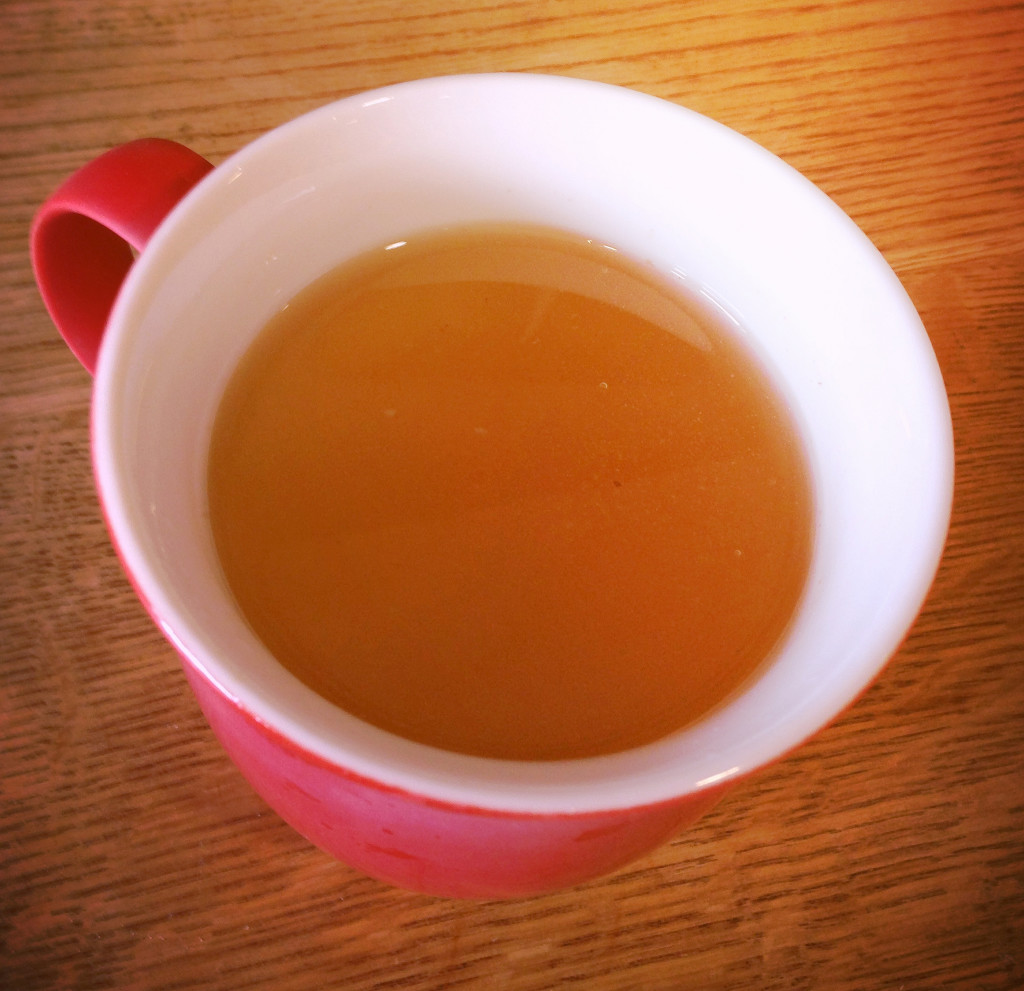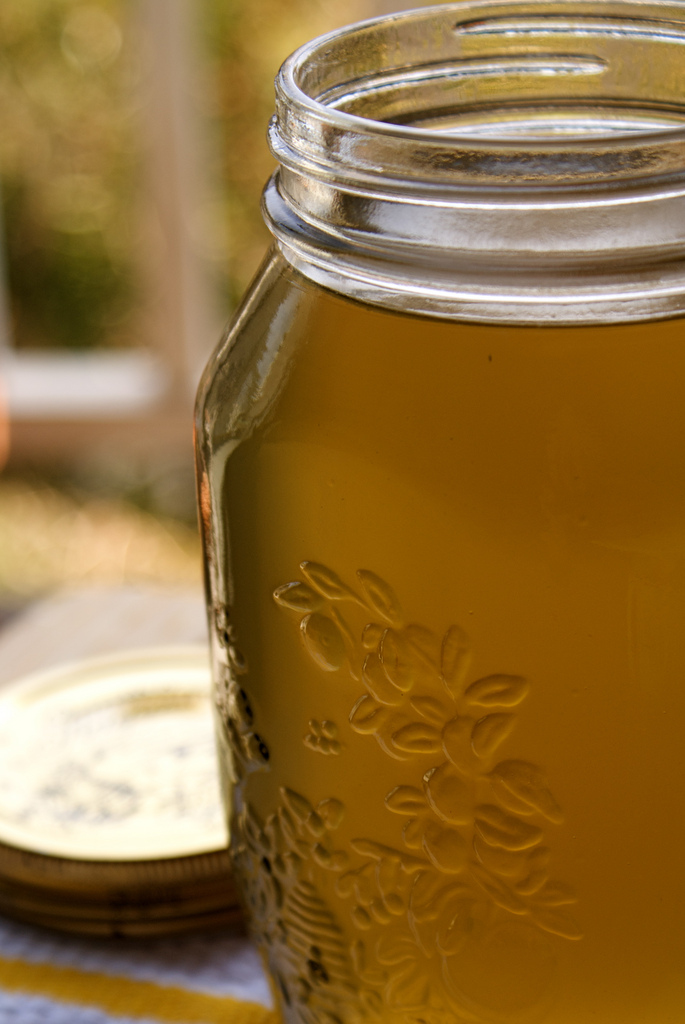A note from your Founding Foodies:
We love bone broth. Amy has some cooking away in her crockpot regularly, and the collection of kitchen scraps in her freezer is begging to take over. She’s become a master food recycling, saving everything from onion peels to carrot tops for use in making this nutrient-dense foodstuff. If you’re already eating a rotisserie chicken—or roasting one yourself—once a week, these scraps make your bone broth basically a bonus food that’s virtually free.
Given all the buzz about bone broth recently, we knew we wanted to revisit the topic first introduced on WTE in May of 2013. We’re bridging the gaps between January’s soup series and February’s Immunity Boosters with a two part series. First up: Kathy McNeely, a nutritionist, health coach, and as you’ll discover—also a big fan of broth. Next week, it’s whole food cheerleader, Sally Fallon Morrell, author of Nourishing Traditions. We’ll be giving away a copy of her latest book, Nourishing Broth, so stay tuned … and get brewing!
I lived and worked in Guatemala for five years, visiting some of the poorest rural villages in this hemisphere. One observation that stayed with me years after I returned to the U.S., was that—in spite of the intense poverty: The whole foods diet of rural Guatemalans kept them strong, healthy and free of many of the preventable diseases that often plague people who rely on the standard American diet.
This insight eventually led me to pursue a career in nutrition counseling and health coaching. I particularly remember that Guatemalans would start their day with delicious soups made from bone broths that used every available bone and body part of the animals they raised. Over my years of study I learned more about the nutritional value of this so-called superfood, and am now a self-proclaimed bone broth champion—cooking up my own at home and encouraging others to do the same.
What is bone broth, and how does it differ from soup?
Bone broth is an ancient tradition dating back to 1000 CE. “Bru,” the Germanic root of the word, means to “prepare by boiling” (McGee, 2007).
Today the terms stock and broth are often used interchangeably. Though professional cooks might make a distinction, for our purposes, both broth and stock are used as the foundational ingredient for making sauces, gravies and soups. They are made through a process which includes a long, rolling boil, and they contain gelatin—a key ingredient that provides incredible texture, fullness and healing properties.
The main distinction cooks make is around seasoning. For them, stocks are thicker and denser and have little flavor. Broths, on the other hand, are more liquid in nature and are seasoned with herbs and spices, which, more often than not, have healing properties. The spices only add to the nutrition that comes from the bones themselves.
A most important first step to making bone broth is to start with quality bones. You will want to use both long bones like legs, backs, hips and shoulders to supply the broth with marrow. When bones with marrow cook, they release important nutritional and immune support factors, including the precursors to both red and white blood cells (Micleu, 2007). You will also want to include boney bones, knuckles, feet and other joints, which contain cartilage. These bones cook down to produce gelatin, loaded with minerals and amino acids that facilitate digestion and promote effective detoxification (Micleu, 2007).
Some commercially produced stocks and broth contain mono-sodium glutamate (MSG). While evidence-based research on the heath impact of MSG is lacking, many people report a sensitivity to it, making store-bought broths and bouillon cubes strictly off-list for affected individuals. Interestingly, MSG was developed in a quest to replicate the umami flavor first discovered in the seaweed kombu, traditionally added to Japanese broths and soups (McGee, 2007 & Morrell-Fallon, 201).
Today, there are numerous MSG-free, organic and free-range stocks available at local health food stores. I like Pacific Organic, Free Range low sodium broths because the are suitable for people with a number of dietary restrictions (low sodium, gluten free, dairy free, soy free and wheat free). These have become a fallback for busy people, but the quality of the broth is much greater if it is home made. Packaged products are usually highly processed and packaged in a sterile environment, they are less flavorful and less-nutrient dense than what one can make at home. And ounce for ounce, it is less expensive to make your own (Nourished Kitchen, 2015).
How is bone broth made?
Recipe instructions vary when working with specific meats (see recipes for chicken and beef stocks), but there are basic principles that apply to both.
- Cold Start: It is important to start with cold water and to slowly bring it to a gentle simmer, which is maintained for several hours. The cold start and slow heating separates soluble from solid proteins, basically allowing any impurities in the bone to aggregate and rise to the surface where they can be easily skimmed off (McGee, 2007).
- Gentle Simmer and skim often: Once the broth is brought to a boil, the heat should be reduced immediately. It is simmered without a lid for several hours. Leaving the broth uncovered while it simmers will keep it from coming to a boil. If a stock is continually boiled impure particles and fat droplets are blended to form a cloudy suspension (McGee, 2007). Impurities that arise from the bone and joints will form a frothy film on the top of the broth. It is important to continually skim this off with a mesh skimmer or ladle to keep the broth clear and free of impurities. The length of time the broth will simmer depends on the type of meat/bones/recipe used.
- Seasoning: Typically salt is not added to a broth. Sodium will come from the bones and give flavoring. Later in the simmering process, when the impurities stop rising to the top, parsley or other healing herbs can be added to the broth – about 15 minutes before it is removed from heat.
- Cool the stock quickly: To keep the broth bacteria-free, it is important to cool the broth quickly in an ice bath to about 70 degrees F rather than letting it cool on at room temperature. It is best to cool it in the stockpot used rather than transferring it to another vessel. It is especially important not to use plastic, which insulates hot food and delays cooling (Labensky & Hause, 2007, p. 221). An ice bath can be made by filling the lower third of a kitchen sink with ice water; the bottom of the pot is then immersed in the ice bath. Occasionally stirring the broth with a slotted spoon in a figure 8 pattern will speed up the cooling process.
- Strain: As the stock cooks, fat will rise to the top. This should be removed before storing the stock. First, solids are removed with a slotted spoon, and then a ladle can be used to ladle stock from pot into fine mesh strainer or large mesh strainer lined with several layers of cheesecloth (Labensky & Hause, 2007, p. 221). Dampening the cheesecloth may help keep the cheesecloth in place.
- Store Properly: No matter how much straining is done, a layer of fat will form on the top of stock or broth. This layer of fat will help preserve the broth, which can be kept refrigerated for 3-4 days. When you are ready to use it, skim the fat off the to and boil it for three minutes to remove impurities that come to the surface. If freezing, transfer to a wide mouth jar and allow at least an inch or two for expansion. Broth will last for up to three months frozen. When ready to use, thaw overnight in the refrigerator.
I usually keep my broth simple adding only a few things like carrot, celery and parsley, so that I can use it as a soup, sauce or stew starter. That way I can keep it versatile creating a Mexican flavor one night and a Thai dish another night. Or, I can just sip it straight up for a mid morning snack.
References:
Fallon, Sally (1999). Nourishing Traditions: The Cookbook that Challenges Politically Correct Nutrition and the Diet Dictocrats (p. 117). National Book Network – A. Kindle Edition. . 118). National Book Network – A. Kindle Edition.
Fallon Morrell, Sally (2014). Nourishing Broth: An Old-Fashioned Remedy for the Modern World (p. 9). Grand Central Publishing. Kindle Edition.
Labensky, S.R., Hause, A.M. (2007). On Cooking: A textbook Of Culinary Fundamentals (fourth edition). Upper Saddle River, NJ: Pearson Prentice Hall
Micleu, C. (2007). Bone Broth For Health Building: Nourishing The Liver And Kidneys. Jade Institute. Seattle, Washington.
McGee, Harold (2007-03-20). On Food and Cooking: The Science and Lore of the Kitchen (Kindle Locations 9646-9667; 16891-16902). Scribner. Kindle Edition.
Nourished Kitchen: Reviving Traditional Foods (2015) Nourished Media, LLC.
Sherrow, G. (2014). “Nutrient dense stocks.” [PDF Document].







[…] Now that your chicken is done and after it’s rested and cooled slightly, remove the meat from the bones. It’s easier to pull now, rather than refrigerating the whole bird for later use. Don’t forget to save the bones for broth! […]